

PopEntertainment.com
>
Feature Interviews - Music >
Feature Interviews K to O >
Loggins and Messina
 Kenny
Loggins and Jim Messina
Kenny
Loggins and Jim Messina
Checkin’ In
by Jay S. Jacobs
Copyright ©2005
PopEntertainment.com. All rights reserved.
Posted:
November
12, 2005.
The band came to be in the early 70s and was made up of
two distinctly talented parts. Jim Messina was a respected producer
and former member of the acclaimed groups Poco and the Buffalo
Springfield. Kenny Loggins was a new kid on the block, an unknown
who had just gotten signed on the strength of a passel of impressive
songs.
Their first album, Sittin' In, was actually
supposed to be a Loggins solo album with Messina producing, but as Messina
got more and more involved in writing, playing and singing it became a duo
album. Sittin' In was released in 1972 to surprising success,
and suddenly they were a partnership.
Loggins and Messina's albums rode atop the charts
throughout the early-mid 70s, spawning hit singles like "Your Mama Don't
Dance (And Your Daddy Don't Rock & Roll)," "Thinking of You" and "My
Music," as well as favorite album tracks like "House on Pooh Corner,"
"Watching the River Run" and "Vahevala." Not only that, Canadian songstress Anne Murray rode
"Danny's Song," a tune that Loggins wrote celebrating his brother's
marriage, to the upper reaches of the charts.
Then after an incredibly productive five-year stint
which spawned an amazing nine albums, Loggins and Messina blew out, the victims of
overwork and stress.
Kenny Loggins went on to become a huge solo star,
notching smash hit singles like "This Is It," "I'm Alright," "Heart To
Heart," "Danger Zone," "Meet Me Halfway" and "Footloose."
Messina has also released several solo albums over the years, as well as
working as a producer and/or a guest guitarist and vocalist on many other
musicians' albums. He also took part in periodic reunions of his old
group Poco.
Nearly three decades on from their breakup, Loggins and
Messina got back together in 2004 to play a triumphant reunion tour which
is now being chronicled in the CD and DVD Loggins and Messina Live: Sittin'
In Again at Santa Barbara Bowl.
A few days before the release of the concert disks, Kenny Loggins and Jim Messina sat down to talk with us about their history and
their reunion.
The album which became Sittin’ In
was supposed to be a Kenny Loggins solo album with Jim
Messina producing. When
did you know that it was going to be a group effort?
Jim Messina:
It really was posed as a question, because the original album was really
designed to introduce Kenny to my audiences, at that time, which would
have been Poco and Buffalo Springfield. I was signed to CBS as a
producer. Kenny was actually my first act under that agreement. In the
process of putting the band [together] and going through all the
processes, the record was released and sold about 150,000 units in a very
short period of time. To the point where CBS – Clive Davis specifically –
had called me and asked me would I consider working with Kenny? At first
I wasn’t. Not because of Kenny, but because I really wanted to focus on
my production career. I’d been on the Springfield and Poco and I was
pretty tired of being on the road, as I had known the road to be. I was
newly married and wanted to be home. I’d spent many years working as an
engineer and wanted to follow through on that craft. The question was
posed to me in a very common sense way. Clive said to me, ‘You know, it’s
not very often that one has the opportunity to have this kind of success.
It’s really there and I’d like you to carefully think about it before you
make a decision.’ He said ‘whatever you want to do, we’ll certainly
support you. But this is a very special project. Give it some
consideration.’ I brought it to Kenny and asked him what he thought.”
Sittin’ In became was high on the
charts for two years and included classic songs like “Danny’s Song” and
“House on Pooh Corner.” Were you surprised how well it was received?
Jim Messina:
I was. I was very surprised, because… to have that kind of reaction
that quickly. I thought it was probably going to take that first
album just to get people to know who Kenny was. Then I figured we
had to do at least a couple of records before he would be to the point
where he’d be selling the kind of records that for him as an artist and me
as a producer I could live on. So, yeah, personally, from my point
of view, I was dumbfounded.
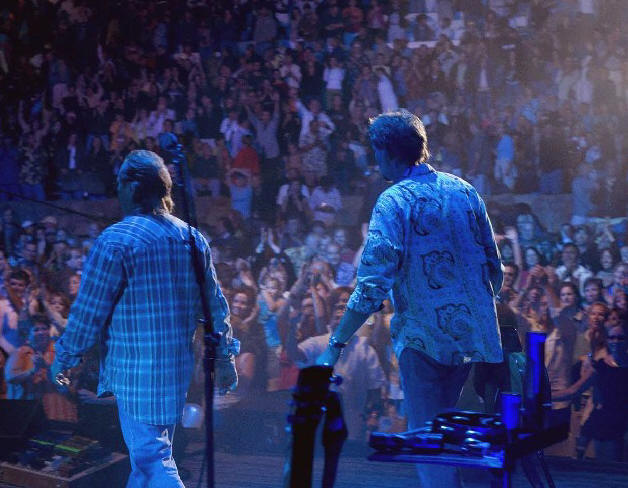 Kenny Loggins:
Jimmy was more the practical thinker,
because he’d had the experience of Buffalo Springfield and Poco. For me,
I was a kid from Alhambra. For the record to take off as quickly as it
did, for the band to take off as quickly as we did – I expected it to
happen. I was incredibly naďve.
Kenny Loggins:
Jimmy was more the practical thinker,
because he’d had the experience of Buffalo Springfield and Poco. For me,
I was a kid from Alhambra. For the record to take off as quickly as it
did, for the band to take off as quickly as we did – I expected it to
happen. I was incredibly naďve.
You both moved to California as kids and were working in the same areas.
Did you know each other or know of each other before you started working
together?
Kenny Loggins:
I knew about Jimmy’s work. I hunted him
down because of his work with Poco and Buffalo Springfield. I knew that
he could create the kind of sound that I wanted to make. But I had to
make myself known to Jimmy.
Jim Messina:
I actually was aware of Kenny, because back before I was working with
Springfield I produced a group called the Deep Six. The Deep Six had a
hit with them called “The Rising Sun” or something like that, or “Rising
Sun”? I don’t remember the name of the song. It was a local hit in the
LA area. (Ed. note: It was called “Rising Sun.”)
I had met Dann Lottermoser and Tony McCashen and a few other folks. Don
Dunn and that group. These were all friends of Kenny’s that I had no idea
that he even knew. So as time went on, I went back to revisit a friend of
mine who was working as an engineer one afternoon
when I walked in and I saw Dann and Tony and this skinny guy with a beard.
I was told his name was Kenny Loggins and I said, oh, he’s got a good
voice, but I’ve got to get back to work. So that was my first meeting of
Kenny. I had no idea that a number of years later we’d be working
together.
On the Loggins and Messina album,
you had your two biggest hit singles with “Your Mama Don’t Dance” and
“Thinking of You.” At that point you were one of the biggest bands
around. What was that
like?
Jim Messina:
I didn’t realize that. Did you realize
that we were one of the biggest bands?
Kenny Loggins:
I’m not going to argue it. (laughs)
It was a lot of fun. It was weird in
that… I was just remembering today about some of my friends from college.
I would invite them to a show and bring them backstage and they’d be
backstage when Jimmy and I’d go on. I’d look back at my friend Doug and
say "What the fuck is this?" It was just so weird. It was so fun. Like
living a dream.
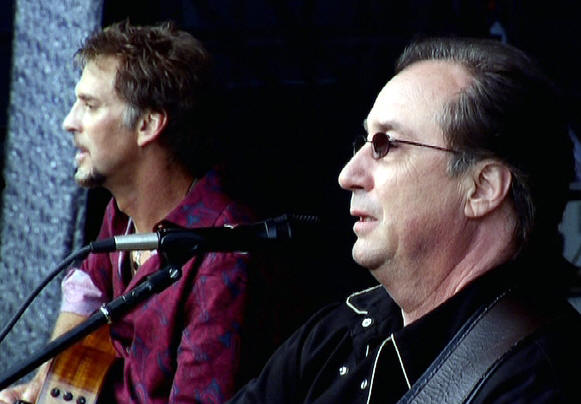 You released five albums of original material, one covers album, two live
albums and a greatest hits album all in about five years. Looking back,
how amazing is it how much you got done in that small amount of time?
You released five albums of original material, one covers album, two live
albums and a greatest hits album all in about five years. Looking back,
how amazing is it how much you got done in that small amount of time?
Jim Messina:
Well, it was, unfortunately I’ve been accused of being a taskmaster…
Kenny Loggins:
Yeah…
Jim Messina: …Or
a slave driver. I knew how important it was for us to get two albums out
a year in order for us to achieve the kind of success and consistency that
touring and having the machine behind you working. And they were willing
to release, they were willing to promote, provided we were willing to do
the same. Having two albums out a year, it really allowed us to jump, and
jump quickly. But it did have it’s toll emotionally and physically on us
as well.
Over the years everyone from Anne Murray to Poison has covered your
songs. What is it like having your songs recorded by others? Are there
any versions you particularly like or dislike?
Jim Messina:
I don’t know. I thought Anne Murray did
a good job on your music.
Kenny Loggins:
Yeah, I’m especially fond of that. Because we didn’t see it coming. She
took “Danny’s Song” off of the Sittin’ In
record and reworked it. So it was a
pleasant surprise to hear somebody getting a hit on it. Over the years,
people associate that song as a hit for me, but it never was. Neither was
“House on Pooh Corner.” Or a half-dozen signature tunes that weren’t
really my hits.
Jim Messina:
For me I think it was interesting to have
a country artist like Lynn Anderson do one of my songs. (Ed.
note: She recorded one
of his Poco songs called “Listen to a Country Song.”) I thought she did a
great job singing it, but I never really cared for the arrangement.
(laughs) But, then again I think
for me I get used to what Kenny and I have done and sometimes it’s hard to
hear. Like, the Poison thing I didn’t understand at all until I went, oh,
that’s their sound. (Ed note: The hair-metal group had a top-ten single with a
1989 cover of “Your Mama Don’t Dance.”) That’s the way they do it.
That’s their fans and then I began to applaud the fact that this is about
an artist’s interpretation and began to see it differently.
Kenny Loggins:
Yeah, there’s a speed metal version of
“Danny’s Song.” (laughs) It’s
very odd.
The two of you hadn’t performed together in almost 30 years. How did you
get back together?
Jim Messina:
It kind of was a very natural process, in
the sense that we both decided to do some charities in our communities. I
reached out to Kenny to see if I could help at all. He said sure, and I
worked with him on the Christmas Unity project. And then I was doing an
arts outreach project up in Santa Ynez about a month later. I asked
him if he could help there and he said he’d be glad to. That sort of was
the catalyst which got us working together again.
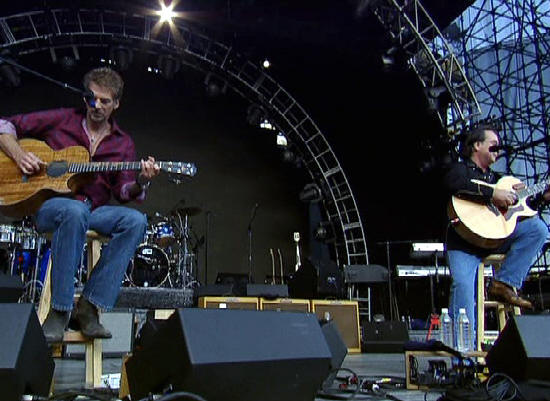 How natural was it to play together
after
all that time, once you made the decision to
give it a try?
How natural was it to play together
after
all that time, once you made the decision to
give it a try?
Jim Messina:
Well, you know, we went back to our
original arrangements, which was really the basis under which we decided
we wanted to redo this. I think for each of us – I know for me I had to
unlearn some things that I had learned as a solo artist on songs that we
had co-written. Even songs that he wrote like “House on Pooh Corner” and
“Danny’s Song” I do in my concerts, because the audiences they look at me
and they don’t see necessarily me, they see Loggins and Messina. So I
play some of those tunes. I had learned to do them differently. So we
just had to learn how to restructure and in some cases, as Kenny was
pointing out earlier today in another interview, we did take pieces from
each of our solo interpretations and made them work for us today.
Something new came from that.
The video and the album was recorded in Santa Barbara, which is your
area. Was it more comfortable making the recording close to home?
Kenny Loggins:
I think in some ways it did. To have your friends out in the audience
smiling and cheering you on is a real positive thing. But I know Jimmy
and I are both pros. We would have put out our best performance no matter
where we were.
Was it hard deciding what was going to go onto the album and DVD? For
example, I was really surprised that “Thinking of You” didn’t make the CD,
although it is on the DVD. “My Music” wasn’t even in the concert, though
it was one of the bonus Midnight Special
tracks.
Kenny Loggins:
We talked it over a lot. We had
suggestions from the company. And from my perspective, I wanted this
compilation of songs to be more representative of the best of Loggins and
Messina. I just didn’t feel that “My Music” was representative of that.
There were other tunes that mattered more. Like, “Same Old Wine,” for
example, there was a whole side to Loggins and Messina that AM radio just
didn’t get. I didn’t want to just regurgitate that same old party line.
“Same Old Wine” still feels as trenchant today as it did when first
recorded. When you were doing it on the tour last year, there was the War
in Iraq and all the division in the Bush and Kerry election. Was it
chosen because the song was still so topical?
Kenny Loggins:
Right. It came to our attention.
Jim Messina:
It wasn’t something we planned. It was
just one of our songs that we wanted to do. But as we were performing it,
we started feeling the immediacy of what the song was saying. Especially
in the reaction the audience was giving to the lyrics.
Were you also trying to experiment with different styles, because you had
stuff like “You Need A Man” which was very bluesy and “Vahevala” which is
more tropical feeling and then stuff like “Danny’s Song” and “Watching the
River Run,” which is more what you’re thought of as being like...
Kenny Loggins:
The folky thing…
Jim Messina:
Well, I think the statement that Kenny
made earlier is that (laughs) AM
radio or FM, depending on who was playing the hits, never really exposed
Kenny and I to what our real interests are. When you hear songs like “You
Need A Man” and you see the extension of the players and the viability of
the musicality. Which even existed back in those days, we had some great
players as well. Jon Clarke. Al Garth. Great horn players. It was
important, for me anyway, for our audiences to see who we really are and
how we’ve grown. So, Kenny and I together, especially, are extremely
diverse. You can hear how diverse Kenny is on his solo career. And me on
my stuff. When you put that together, we’ve got a lot of styles of music
that we love to do.
Speaking of the solo careers… Kenny has had a very successful career since
leaving the band and Jim has also done a decent amount of solo and band
work since you left the band. However, none of your later works were
included on the CD/DVD. Did you ever consider doing any of the stuff you
had done post-Loggins & Messina
in the concerts and recording? Was that a
decision you made right off the bat, or it just felt more natural when you
were working together?
Jim Messina:
Well, we did decide off the bat to do
songs from the old days. As you pointed out, there were songs that we
couldn’t even get on. Too little time to do. That was our focus.
Kenny Loggins:
We kicked it around a little while. But,
felt that it was best to focus on the Loggins and Messina years and keep
it a time capsule piece.
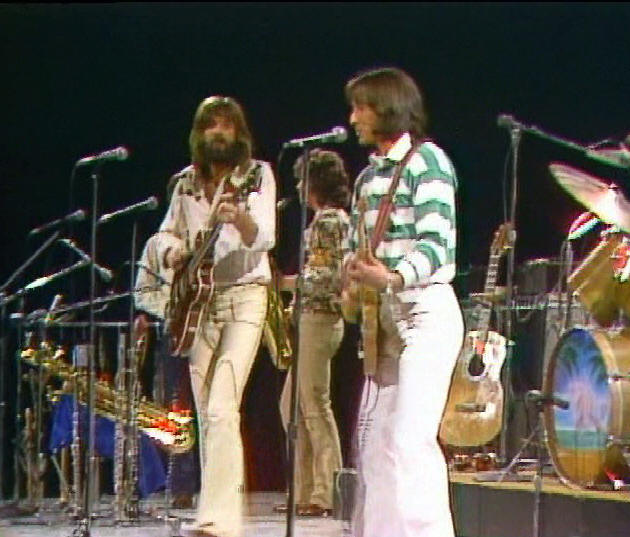 Speaking of a time capsule, I really loved the tracks from the
Midnight Special in 1973
(which are included as a bonus on the DVD). How long had it been since you’d seen them? How
weird was it like to look back at that?
Speaking of a time capsule, I really loved the tracks from the
Midnight Special in 1973
(which are included as a bonus on the DVD). How long had it been since you’d seen them? How
weird was it like to look back at that?
Kenny Loggins:
Go ahead, Jim…
Jim Messina:
How weird was it? (laughs)
Well I didn’t recognize myself. It was kind of interesting. For me it
took me back to who I was married to, what I liked to eat, what kind of
dog I had at the time. Kind of took me back into thinking about those
things. It was interesting to see the energy and the fact that we were
very young. Also looking at myself, who I am today and who I was then was
a trip.
Now that you have gotten back together to tour, are you working on any new
studio recordings as well?
Kenny Loggins:
We’ve talked about it. We’ve left it alone for the tour,
because we didn’t want to add any more pressure on than we had. There is
the possibility. But it’s not immediate. Right now, my biggest pole
emotionally and artistically is to drop more deeply into my solo album.
I’m about four tunes in and maybe twelve more to go or so before I throw
them together and see what I’ve got. So it’s a bit of a process. But I
want to focus in on that. If something were to emerge, if a record
company were to suddenly show up and say, you know, ‘we’ve got a million
bucks here, you guys wanna make a record?’ I’d have to look real seriously
at that. Because once we have a recording budget then we could see. I
have a dozen tunes that I started back then that I’d love to see how they
finish. It’d be fun to go back and see what Jimmy and I would bring to a
song that was started thirty years ago.
The music business has changed so much since your heyday.
When you were releasing songs, you used to be able to hear rock, pop,
country and soul on the same radio station, and that just doesn't happen
anymore. Do you think that can make it tougher for music to get out there
to an audience?
Jim Messina: Oh, absolutely. There’s also other ways to do
things today and Kenny and I have talked about this and, you know, if
you’re a large enough performing act and people want to come to see you,
records are almost like souvenirs anymore. You pay more for a
t-shirt than you do for a record. You invest a hell of a lot less
into a t-shirt than you do to a record. The question is, as a performing act, is there an avenue there?
One of the things I’m very looking forward to is this PBS broadcast of our
DVD, to see how people act and react to that. Because maybe our
medium is not necessarily the radio. Maybe it’s more the type of
audience who are buying DVDs today. I buy more DVDs than I buy CDs.
I’m more interested in the drama and in many cases, I think, some of the
music soundtracks are a hell of a lot more interesting that what I hear on
the radio.
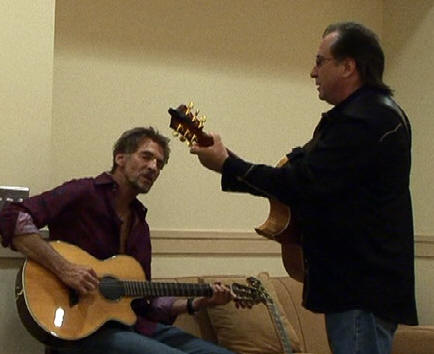 Yeah, I was also reading a story just today about touring –
how bands who are having hits now are not necessarily doing well on the
road, the established groups that may not sell as many new disks are the
ones who are getting the crowds…
Yeah, I was also reading a story just today about touring –
how bands who are having hits now are not necessarily doing well on the
road, the established groups that may not sell as many new disks are the
ones who are getting the crowds…
Jim Messina:
I’m sure that that’s a case in point. But I think what I
learned this year is that I enjoyed the… I don’t know how to say this…
maybe the privacy that we had in terms of being able to tour. We have our
audiences. It would seem to me that if we could get enough people to come
that we might do very well with our sales, even off of our concerts and
websites, to where, if we owned the product, it ends up maybe netting
more. All in all, it could make it more enjoyable and less frustrating if
I don’t expect to have a hit record on the radio. (chuckles) A
hit record selling a million units is a hit record whether it’s played or
not, isn’t it?
In the end, how would you like people to see your music?
Jim Messina:
I’ll let you go with that.
Kenny Loggins:
Well, I think that the overall answer… I’m a little tired
right now – long day… But I would think just for people to remember us as
a quality act. That we spoke… we made music that was appropriate for the
times. And was a part of people’s lives. Just that it was quality
music. Not disposable stuff.
Jim Messina:
I think probably to add to that is the fact that when we
did come back, and we did perform the music, that not only did we not
disappoint our audiences, but they were appreciative of the energy and the
new life that had been brought to this music. So, in a way, I think that
the reviews kind of reflected your question, in terms of how people have
remembered us.
Are there any misconceptions you'd like to clear up
about Loggins and Messina?
Kenny Loggins:
Neither of us are gay. (laughs) Although we’re
happy.